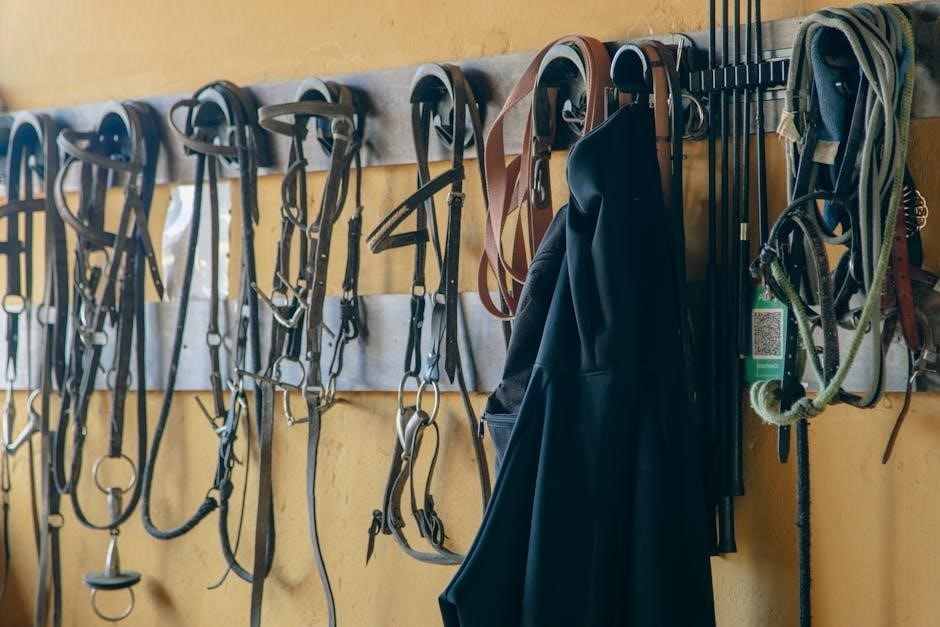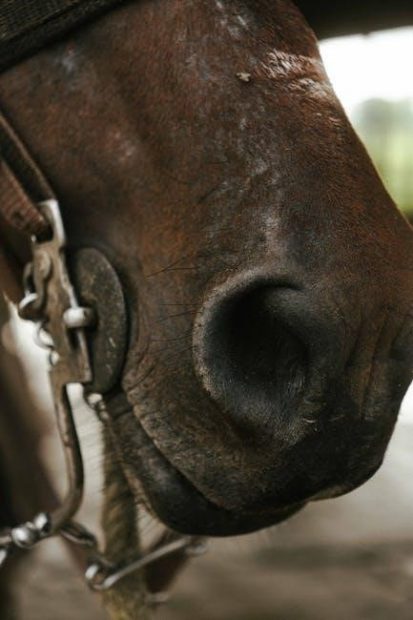Horse bits are essential tools in equestrian communication, connecting riders to horses. They guide movement through gentle pressure, ensuring clear and effective control. Historically, bits have evolved significantly.
What is a Horse Bit?
A horse bit is a metal or synthetic device placed in a horse’s mouth, attached to reins, allowing riders to communicate and guide the horse. It applies pressure to the mouth, tongue, or other areas, influencing the horse’s movement and behavior. Bits vary in design, material, and function to suit different needs and disciplines.
The Purpose of a Horse Bit
The purpose of a horse bit is to facilitate clear communication between the rider and the horse. It applies pressure to specific areas in the horse’s mouth, enabling the rider to guide movement, maintain control, and ensure harmony during training or riding. Bits help in achieving precise cues and balanced interaction.
A Brief History of Horse Bits
Horse bits date back to ancient civilizations, with early examples made from bronze and copper. Egyptians and Greeks used basic bits for control. Over centuries, designs evolved, reflecting advances in metallurgy and equestrian knowledge; Today, bits vary widely, catering to specific disciplines and horse needs, while maintaining their core purpose of aiding communication between horse and rider.

Types of Horse Bits
Snaffle Bits
Snaffle bits are the most common type, featuring a jointed mouthpiece. They are mild and suitable for young or sensitive horses, promoting gentle control and clear communication.
Snaffle bits are the most common type, known for their jointed mouthpiece. They apply pressure to the horse’s bars and lips, offering mild control. Ideal for young or sensitive horses, snaffle bits promote gentle communication and are widely used in training. Popular styles include eggbutt, loose ring, and full cheek snaffles, each suited for specific needs and disciplines.
Curb Bits
Curb bits use a combination of leverage and pressure to achieve precise control. They feature a chain or strap under the horse’s chin, amplifying the rider’s commands. Curb bits are typically used for advanced training or specific disciplines, requiring experienced riders to avoid discomfort or resistance. Proper fitting and use are crucial for horse comfort and effectiveness.
Combination Bits
Combination bits merge elements of snaffle and curb bits, offering versatility for training. They often feature adjustable cheeks and unique mouthpieces, allowing riders to customize pressure points. This design provides a tailored approach to communication, making them ideal for addressing specific training challenges while maintaining clarity and responsiveness in the horse.
Specialty Bits
Specialty bits are crafted for specific needs, offering unique designs and materials. They address behavioral challenges or provide extra comfort, with options like rubber or mullen mouths. These bits cater to horses with unique requirements, ensuring tailored communication and comfort, making them invaluable for particular training scenarios or sensitive horses.
How Horse Bits Work
Horse bits transmit signals from reins to the horse’s mouth, guiding movement through pressure. Proper fit and design ensure balance, comfort, and clear communication between horse and rider.
The Mechanics of a Horse Bit
A horse bit operates by transmitting signals from the reins to the horse’s mouth. The mouthpiece applies pressure to the bars, tongue, and lips, while rings or cheeks connect to the reins. Leverage increases pressure based on rein tension, and curb chains or poll pressure enhance control. Proper mechanics ensure clear communication and comfort for the horse.
Pressure Points and Their Effects
Horse bits apply pressure to specific areas in the mouth, including the bars, tongue, and lips. The mouthpiece design determines pressure distribution. Mullen mouths provide even pressure, while jointed snaffles can cause pinching if not fitted correctly. Excessive or misapplied pressure may lead to discomfort, causing the horse to resist or exhibit behavioral issues during training or riding activities.
The Role of Leverage in Bits
Leverage in bits amplifies the rider’s rein pressure, applying force beyond the mouth to areas like the poll and chin groove. Curved or angled bits create more leverage, increasing control but requiring careful use to avoid discomfort. Proper fit is essential to ensure leverage enhances communication without causing resistance or discomfort for the horse.

Selecting the Right Bit for Your Horse
Selecting the right bit involves considering the horse’s breed, size, and training level, as well as the rider’s experience and discipline. Proper fit and material ensure comfort and effective communication, making it easier to guide the horse. Professional guidance is recommended to optimize both horse and rider performance.
Factors to Consider When Choosing a Bit
When selecting a bit, consider the horse’s age, breed, and mouth structure. The rider’s experience, riding style, and discipline are crucial. Ensure proper fit to avoid discomfort. Material choice impacts comfort and responsiveness. Professional fitting ensures optimal performance and horse well-being. Additionally, the horse’s training level and specific needs should guide the decision.
Bit Size and Fit
Proper bit size and fit are crucial for comfort and effectiveness. The bit should sit snugly, allowing about a quarter-inch of space on each side. It must rest on the horse’s bars without pinching. Professional fitting ensures optimal comfort and functionality, tailored to the horse’s unique mouth structure and needs.
Bit Material and Design
Bit materials vary, including stainless steel, copper, and rubber, each offering unique benefits. Design options like jointed, straight-bar, or mullen-mouth cater to different horses’ needs. The right material and design ensure comfort, clear communication, and optimal performance, making them essential for effective training and riding experiences.
Bit Care and Maintenance
Regular cleaning and sanitizing maintain hygiene and durability. Proper storage prevents rust, and inspections ensure safety and optimal performance over time.
Cleaning and Sanitizing Bits
Cleaning and sanitizing bits are crucial for maintaining hygiene and preventing the spread of infections. Use mild soap and warm water to scrub away dirt and saliva. Avoid harsh chemicals that can damage materials or harm the horse’s mouth. Regular sanitizing ensures a clean, safe surface for optimal performance and horse comfort.
Storing Bits Properly
Proper storage is key to maintaining bit quality and longevity. Keep bits in a clean, dry place, away from extreme temperatures. Store each bit individually to prevent scratching. Regularly inspect stored bits for wear or damage. Use soft materials like cloth or foam to protect delicate parts during storage.
Regular Inspection and Maintenance
Regularly inspect bits for wear, rust, or corrosion. Clean and lubricate moving parts to ensure smooth operation. Replace worn components promptly to prevent discomfort or injury. Maintain proper alignment and balance in curb chains and straps. Regular maintenance ensures safety, comfort, and effective communication between horse and rider.
Legal and Safety Considerations
Safety is paramount when using horse bits; Ensure compliance with competition rules and regulations. Always choose bits appropriate for your horse’s needs and discipline. Proper fitting and usage are essential to prevent harm and ensure effective communication.
Bit Regulations in Competitions
Competitions enforce strict bit regulations to ensure fairness and horse welfare. Riders must use bits that meet specific material, size, and design criteria. Certain bits, like those with excessive leverage, may be prohibited. Always verify rules with governing bodies like the FEI or USEF to avoid disqualification. Stay informed to comply with current standards.
Safety Tips for Using Horse Bits
Ensure bits are properly fitted to avoid discomfort or injury. Regularly inspect for wear and tear, and choose materials suitable for your horse’s needs. Introduce bits gradually, especially to young or sensitive horses. Store bits clean and dry to prevent damage. Always follow manufacturer guidelines and seek professional advice if unsure.

Troubleshooting Common Bitting Issues
Identify issues like discomfort or resistance by observing your horse’s behavior. Adjust bits for proper fit and consider consulting a professional for tailored solutions.
Identifying Bit-Related Problems
Monitor your horse’s behavior for signs of discomfort or resistance, such as head tossing, mouth opening, or reluctance to respond. These may indicate improper fit, excessive pressure, or the wrong bit type for your horse’s needs. Addressing these issues promptly ensures comfort and effective communication.
Adjusting Bits for Optimal Comfort
Ensure the bit fits properly, sitting comfortably without causing pressure points. Adjust the cheek pieces so the bit rests gently on the horse’s bars. Monitor for signs of discomfort, such as head shaking or chewing. If issues persist, consider trying a different bit type or seeking professional advice for proper fitting.

Training with Horse Bits
Training with horse bits begins with introducing them to young horses gently. Proper techniques ensure comfort and clear communication, building trust and responsiveness between horse and rider.
Introducing Bits to Young Horses
Introducing bits to young horses requires patience and care to ensure a positive experience. Start with a mild, comfortable bit, like a mullen mouth or rubber bit, to avoid discomfort. Begin by letting the horse explore the bit in a relaxed environment, then gradually incorporate it into training sessions with positive reinforcement.
Transitioning Between Different Bits
Transitioning between bits should be done gradually to allow the horse to adapt. Start by introducing the new bit during short sessions, mixing it with the familiar one. Monitor the horse’s response and comfort, ensuring a smooth adjustment. This approach prevents resistance and maintains trust in the training process, fostering a positive experience for both horse and rider.
Advanced Training Techniques with Bits
Advanced training techniques with bits focus on precision and nuanced communication. Riders use specific exercises like lateral work and collection to enhance the horse’s responsiveness. These methods require expertise and clear cues, ensuring the horse understands and executes complex movements seamlessly. Proper bit selection is crucial to refine performance and strengthen the horse-rider partnership.

Future Trends in Horse Bits
Future trends include innovative bit designs with advanced materials and technologies, such as smart bits offering real-time feedback, enhancing horse-rider communication and comfort.
Innovations in Bit Design
Innovations in bit design focus on enhancing horse comfort and communication. Advanced materials like titanium and ergonomic shapes reduce pressure points. Smart bits with sensors provide real-time feedback on fit and performance. Customizable options and adjustable leverage systems cater to individual horse needs, promoting better responsiveness and rider control.
New Materials and Technologies
Modern materials like titanium, copper, and synthetic polymers are revolutionizing bit design. These materials offer improved durability, corrosion resistance, and heat conductivity. Technologies such as adjustable leverage systems and smart sensors provide real-time feedback, enhancing fit and performance. These innovations prioritize horse comfort and effectiveness in communication between horse and rider.
Buyer’s Guide to Horse Bits
Selecting the right bit involves considering your horse’s breed, discipline, and comfort. Explore reputable stores, try bits before buying, and consult professionals for proper fitting to ensure optimal comfort and effectiveness.
Where to Buy High-Quality Bits
Reputable equestrian stores, both online and in-person, offer high-quality bits. Look for trusted brands and read reviews to ensure durability and comfort. Professional fitters can also guide you to the best options tailored to your horse’s specific needs, ensuring a perfect fit and optimal performance.
Trying Before Buying
Trying a bit before purchasing ensures comfort and effectiveness. Work with a professional fitter to assess fit and performance. Use a muzzle or bridle to simulate real conditions. Observe the horse’s posture, chewing, and responsiveness. This hands-on approach ensures the right choice for your horse’s needs, avoiding costly mistakes and ensuring optimal performance.
The Importance of Professional Fitting
Professional fitting ensures the bit is correctly sized and positioned for optimal comfort and effectiveness. A poorly fitted bit can cause discomfort or miscommunication. Experts assess the horse’s mouth shape, size, and behavior to recommend the best fit, enhancing performance and ensuring the horse’s well-being. This personalized approach is invaluable for long-term success.
